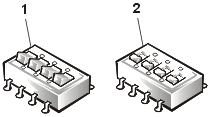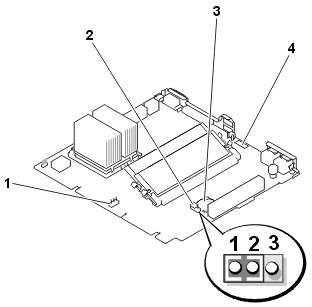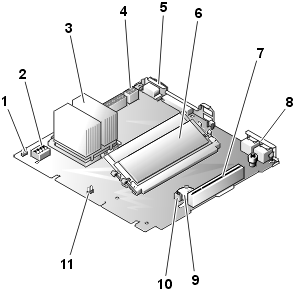Dell™ PowerVault™ 715N Systems Service Manual
| Overview | System Board Jumpers | ||
|
|
Jumpers — A General Explanation | System Board Features |
This section provides specific information about the jumpers on the system board. It also provides some basic information about jumpers and describes the connectors and sockets on the various boards in the system.
Jumpers provide a convenient and reversible way of reconfiguring the circuitry on a printed circuit board. When installing replacement parts or reconfiguring the system, you might need to change jumper settings on the system board. You might also need to change jumper settings on expansion cards or drives.
Jumpers are small blocks on a circuit board with two or more pins emerging from them (see Figure 1). Plastic plugs containing a wire fit down over the pins. The wire connects the pins and creates a circuit. To change a jumper setting, pull the plug off its pin(s) and carefully fit it down onto the pin(s) indicated.
 |
| NOTICE: Make sure the system is turned off before you change a jumper setting. Otherwise, damage to the system or unpredictable results might occur. |
A jumper is referred to as open or unjumpered when the plug is pushed down over only one pin or if there is no plug at all. When the plug is pushed down over two pins, the jumper is referred to as jumpered. The jumper setting is often shown in text as two numbers, such as 1-2. The number 1 is printed on the circuit board so that you can identify each pin number based on the location of pin 1.
Switches control various circuits or functions in the system. The switches that you are most likely to encounter are dual in-line-package (DIP) switches, which are normally packaged in groups of two or more switches in a plastic case. Two common types of DIP switches are slide switches and rocker switches (see Figure 2). The setting of the rocker type DIP switches at SW3 on the system board are not to be changed from their open or off setting (see Figure 4)
| NOTICE: All DIP switch (SW3) positions must remain in the OFF position. Do not change these DIP switch settings. |
 |
|
Each of the switches has two positions or settings (usually on and off). To change the setting of a slide switch, use a small pointed object such as a small screwdriver or a straightened paper clip to slide the switch to the proper position. To change the setting of a rocker switch, use the screwdriver or paper clip to press down on the appropriate side of the switch. In either case, do not use a pen, pencil, or other object that might leave a residue on the switch.
Figure 3 shows the location of the Clear CMOS jumper and the system version jumper on the system board. Table 1 lists the jumper setting information.
For instructions on using the Clear CMOS jumper to clear CMOS, see "Clearing CMOS."
Earlier systems with a system version number of SN1A have the JP5 jumper set on pins 1 and 2. Later systems with a system version number of SN1B have the JP5 jumper set on pins 2 and 3. Do not change these jumper settings.
| NOTICE: All DIP switch (SW3) positions must remain in the OFF position. Do not change these DIP switch settings. |
Figure 3. System Board Jumpers
 |
|
Table 1. System-Board Jumper Settings
| Jumper | Setting | Description | |
|---|---|---|---|
| Clear
CMOS (JP1) |
pins
1-2 (pins 2-3) |
(default) |
The password feature is enabled. The password feature is disabled. |
| System version jumper (JP5) | pins 1-2 pins 2-3 |
(default
for early systems) (default for later systems) |
Use in
this position for early system boards with a version number of SN1A (do not change). Use in this position for later system boards with a version number of SN1B (do not change). |
Figure 4 defines the system board features, including switches, connectors, and labels located on the system board. The system board labels are in parentheses.
Figure 4. System Board Features
 |
|